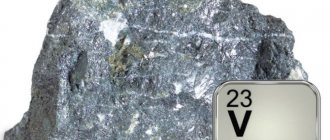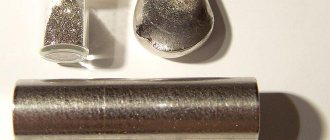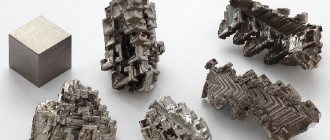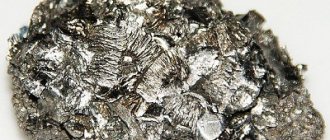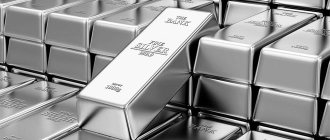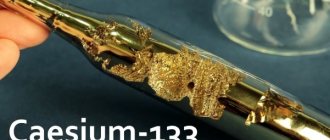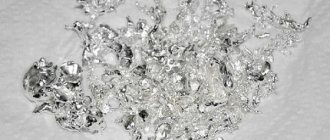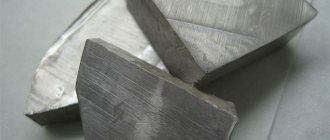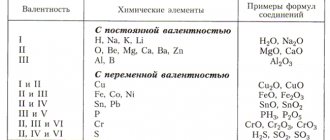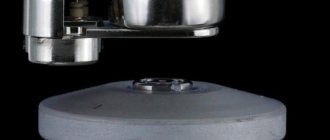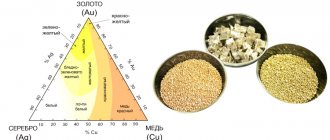Among the 115 chemical elements known today, many received their names in honor of the heroes of Greek myths, gods. Others named discoverers and famous scientists by their surnames. Still others were named after countries, cities, and geographical areas. The history of the name of such an element as vanadium is especially interesting. And this metal itself is quite important and has special characteristics. Therefore, let's look at it in more detail.
General information:
| 100 | General information | |
| 101 | Name | Vanadium |
| 102 | Former name | |
| 103 | Latin name | Vanadium |
| 104 | English name | Vanadium |
| 105 | Symbol | V |
| 106 | Atomic number (number in table) | 23 |
| 107 | Type | Metal |
| 108 | Group | Amphoteric, transitional, ferrous metal |
| 109 | Open | Andres Manuel del Rio Fernandez, Mexico, 1801, Nils Gabriel Sefström, Sweden, 1830 |
| 110 | Opening year | 1801 |
| 111 | Appearance, etc. | Ductile metal, silver-gray |
| 112 | Origin | Natural material |
| 113 | Modifications | |
| 114 | Allotropic modifications | |
| 115 | Temperature and other conditions for the transition of allotropic modifications into each other | |
| 116 | Bose-Einstein condensate | |
| 117 | 2D materials | |
| 118 | Content in the atmosphere and air (by mass) | 0 % |
| 119 | Content in the earth's crust (by mass) | 0,019 % |
| 120 | Content in seas and oceans (by mass) | 1,5·10-7 % |
| 121 | Content in the Universe and space (by mass) | 0,0001 % |
| 122 | Abundance in the Sun (by mass) | 0,00004 % |
| 123 | Content in meteorites (by mass) | 0,0061 % |
| 124 | Content in the human body (by weight) | 3,0·10-6 % |
Production and use of metal
Vanadium is obtained by isolating it from rocks and ores. Moreover, those minerals that contain even 1% metal are considered extremely rich in vanadium. After separating the sample of the iron and vanadium mixture, it is transferred to a concentrated solution. Sodium vanadate is isolated from it by acidification, from which a highly concentrated sample is subsequently obtained, with a metal content of up to 90%.
This dried residue is then calcined in a furnace and the vanadium is reduced to its metallic state. In this form, the material is ready for use.
Vanadium is a chemical element that is widely used in industry. Especially in mechanical engineering and steel alloy smelting. Several main uses of metal can be identified.
- Textile industry.
- Glassmaking.
- Production of ceramics and rubber.
- Paint and varnish industry.
- Production and synthesis of chemicals (sulfuric acid production).
- Manufacturing of nuclear reactors.
- Aviation and shipbuilding, mechanical engineering.
Vanadium is a very important alloying component for the production of light, strong, corrosion-resistant alloys, mainly steel. It’s not called “automotive metal” for nothing.
Properties of the vanadium atom:
| 200 | Properties of the atom | |
| 201 | Atomic mass ( molar mass ) | 50.9415(1) amu (g/mol) |
| 202 | Electronic configuration | 1s2 2s2 2p6 3s2 3p6 3d3 4s2 |
| 203 | Electronic shell | K2 L8 M11 N2 O0 P0 Q0 R0 |
| 204 | Atomic radius (calculated) | 171 pm |
| 205 | Empirical atomic radius* | 135 pm |
| 206 | Covalent radius* | 153 pm |
| 207 | Ion radius (crystalline) | Ti2+ 100 (6) pm, Ti3+ 81 (6) pm, Ti4+ 56 (4) pm, 74.5 (6) pm (in parentheses the coordination number is indicated - a characteristic that determines the number of nearest particles (ions or atoms) in a molecule or crystal) |
| 208 | Van der Waals radius | |
| 209 | Electrons, Protons, Neutrons | 23 electrons, 23 protons, 28 neutrons |
| 210 | Family (block) | d-family element |
| 211 | Period in the periodic table | 4 |
| 212 | Group on the periodic table | 5th group (according to the old classification - a secondary subgroup of the 5th group) |
| 213 | Emission spectrum |
Story
Vanadium
was discovered in 1801 by Andres Manuel Del Rio, a professor of mineralogy from Mexico City, in lead ores. He discovered a new metal and proposed the name "panchromium" for it due to the wide range of colors of its compounds, then changing the name to "erythronium". Del Rio had no authority in the scientific world of Europe, and European chemists doubted his results. Then Del Rio himself lost confidence in his discovery and declared that he had discovered only lead chromate.
In 1830, vanadium was rediscovered in iron ore by the Swedish chemist Nils Säfström. The name of the new element was given by Berzelius and Sefström.
Friedrich Wöhler, who was exploring Mexican ore, had a chance to discover vanadium, but he was seriously poisoned by hydrogen fluoride shortly before Sefström's discovery and was unable to continue his research. However, Wöhler completed the study of the ore and finally proved that it contained vanadium and not chromium.
Chemical properties of vanadium:
| 300 | Chemical properties | |
| 301 | Oxidation states | -3, -1, 0, +1, +2, +3, +4, +5 |
| 302 | Valence | II, III, IV, V |
| 303 | Electronegativity | 1.63 (Pauling scale) |
| 304 | Ionization energy (first electron) | 650.91 kJ/mol (6.746187(21) eV) |
| 305 | Electrode potential | V3+ + e— → V2+, Eo = -0.255, V3+ + 3e— → V, Eo = -0.255, V2+ + 2e— → V, Eo = -0.255, |
| 306 | Electron affinity energy of an atom | 50.911(20) kJ/mol (0.52766(20) eV) |
Isotopes
If we talk about the prevalence of the atom in question in nature, then vanadium is a chemical element that is classified as dispersed. It is part of almost all large rocks, ores and minerals. But nowhere is it more than 2%.
The content in the earth's crust is significant and amounts to 1.9 * 10-7. According to this indicator, it is ahead of copper, zinc, and lead. The metal does not form its own rocks, but there are several deposits that are considered vanadium. They contain iron, in the crystal lattice of which vanadium atoms are built in large quantities.
These are breeds such as:
- vanadinite;
- patronizes;
- carnotite;
- chillit.
You can also find the metal in question in the composition:
- plant ash;
- ocean water;
- bodies of ascidians, holothurians;
- organisms of terrestrial plants and animals.
If we talk about isotopes of vanadium, then there are only two of them: with a mass number of 51, of which the vast majority is 99.77%, and with a mass number of 50, which is diffuse radioactive and occurs in negligible quantities.
Physical properties of vanadium:
| 400 | Physical properties | |
| 401 | Density* | 6.11 g/cm3 (at 0 °C/20 °C and other standard conditions , state of matter – solid), 5.5 g/cm3 (at melting point 1910 °C and other standard conditions , state of matter – liquid) |
| 402 | Melting temperature* | 1910 °C (2183 K, 3470 °F) |
| 403 | Boiling temperature* | 3407 °C (3680 K, 6165 °F) |
| 404 | Sublimation temperature | |
| 405 | Decomposition temperature | |
| 406 | Self-ignition temperature of a gas-air mixture | |
| 407 | Specific heat of fusion (enthalpy of fusion ΔHpl)* | 21.5 kJ/mol |
| 408 | Specific heat of evaporation (enthalpy of boiling ΔHboiling)* | 444 kJ/mol |
| 409 | Specific heat capacity at constant pressure | 0.502 J/g K (at 20-100 °C) |
| 410 | Molar heat capacity* | 24.89 J/(K mol) |
| 411 | Molar volume | 8.3373977 cm³/mol |
| 412 | Thermal conductivity | 30.7 W/(mK) (at standard conditions ), 30.7 W/(mK) (at 300 K) |
| 413 | Thermal expansion coefficient | 8.4 µm/(MK) (at 25 °C) |
| 414 | Thermal diffusivity coefficient | |
| 415 | Critical temperature | |
| 416 | Critical pressure | |
| 417 | Critical Density | |
| 418 | Triple point | |
| 419 | Vapor pressure (mmHg) | |
| 420 | Vapor pressure (Pa) | |
| 421 | Standard enthalpy of formation ΔH | |
| 422 | Standard Gibbs energy of formation ΔG | |
| 423 | Standard entropy of matter S | |
| 424 | Standard molar heat capacity Cp | |
| 425 | Enthalpy of dissociation ΔHdiss | |
| 426 | The dielectric constant | |
| 427 | Magnetic type | |
| 428 | Curie point | |
| 429 | Volume magnetic susceptibility | |
| 430 | Specific magnetic susceptibility | |
| 431 | Molar magnetic susceptibility | |
| 432 | Electric type | |
| 433 | Electrical conductivity in the solid phase | |
| 434 | Electrical resistivity | |
| 435 | Superconductivity at temperature | |
| 436 | Critical magnetic field of superconductivity destruction | |
| 437 | Prohibited area | |
| 438 | Charge carrier concentration | |
| 439 | Mohs hardness | |
| 440 | Brinell hardness | |
| 441 | Vickers hardness | |
| 442 | Sound speed | |
| 443 | Surface tension | |
| 444 | Dynamic viscosity of gases and liquids | |
| 445 | Explosive concentrations of gas-air mixture, % volume | |
| 446 | Explosive concentrations of a mixture of gas and oxygen, % volume | |
| 446 | Ultimate tensile strength | |
| 447 | Yield strength | |
| 448 | Elongation limit | |
| 449 | Young's modulus | |
| 450 | Shear modulus | |
| 451 | Bulk modulus of elasticity | |
| 452 | Poisson's ratio | |
| 453 | Refractive index |
Being in nature
Vanadium is the 20th most abundant element in the earth's crust. It belongs to the trace elements and is not found in nature in free form. The vanadium content in the earth's crust is 1.6⋅10−2% by mass, in ocean water 3⋅10−7%. The highest average vanadium contents in igneous rocks are observed in gabbro and basalts (230-290 g/t). In sedimentary rocks, significant accumulation of vanadium occurs in biolites (asphaltites, coals, bituminous phosphates), bituminous shales, bauxites, as well as in oolitic and siliceous iron ores. The proximity of the ionic radii of vanadium and iron and titanium, which are widespread in igneous rocks, leads to the fact that vanadium in hypogene processes is entirely in a dispersed state and does not form its own minerals. Its carriers are numerous titanium minerals (titanomagnetite, sphene, rutile, ilmenite), micas, pyroxenes and garnets, which have an increased isomorphic capacity with respect to vanadium. The most important minerals: patronite V(S2)2, vanadinite Pb5(VO4)3Cl and some others. The main source of vanadium is iron ores containing vanadium as an impurity.
Vanadyl ion () is found in abundance in seawater, having an average concentration of 30 nMa. Some mineral water sources also contain the ion in high concentrations. For example, springs near Mount Fuji contain up to 54 micrograms per liter.
Vanadium crystal lattice:
| 500 | Crystal cell | |
| 511 | Crystal grid #1 | |
| 512 | Lattice structure | Cubic body-centered |
| 513 | Lattice parameters | 3.024 Å |
| 514 | c/a ratio | |
| 515 | Debye temperature | 390 K |
| 516 | Name of space symmetry group | Im_ 3m |
| 517 | Symmetry space group number | 229 |
Elusive
Isolating vanadium metal in its pure form has proven difficult. Before this, scientists worked only with its salts. That is why the true properties of vanadium are unknown. In 1831, Berzelius reported obtaining a metallized substance, but Henry Enfield Roscoe proved that Berzelius had actually produced vanadium nitride (VN). Roscoe eventually produced the metal in 1867 by reducing vanadium chloride (VCl 2) with hydrogen. Since 1927, pure vanadium has been obtained by reducing vanadium pentoxide with calcium.
The first serial industrial use of the element dates back to 1905. The metal was added to a steel alloy for racing car chassis and later to the Ford Model T. Vanadium's characteristics help reduce structural weight while increasing tensile strength. By the way, the German chemist Martin Henze discovered vanadium in the blood cells (or coelomic cells) of marine inhabitants - accidia - in 1911.
Production
Vanadium is primarily used as an additive to steel alloys called ferroalloys. Ferrovanadium is produced directly by reducing a mixture of valence (V) vanadium oxide, iron oxides and pure iron in an electric furnace.
The metal is produced using a multi-step process that begins by roasting ground vanadium magnetite ore with the addition of sodium chloride (NaCl) or sodium carbonate (Na2CO3) at about 850°C to produce sodium metavanadate (NaVO3). An aqueous extract of this substance is acidified to obtain a polyvanadate salt, which is reduced with calcium metal. As an alternative to small-scale production, vanadium pentoxide is reduced with hydrogen or magnesium.
Many other methods are also used, all of which produce vanadium as a by-product of other processes. Its purification is possible using the iodide method, developed by Anton Eduard van Arkel and Jan Hendrik de Boer in 1925. It involves the formation of vanadium (III) iodide and its subsequent decomposition to produce pure metal:
2 V + 3I 2 ⇌ 2 VI 3
The Japanese came up with a rather exotic way to obtain this element. They breed ascidians (a type of chordata) in underwater plantations, which absorb vanadium from sea water. They are then collected and burned. Valuable metal is extracted from the resulting ash. By the way, its concentration in this case is much higher than in the richest deposits.
Oxide
The most commercially important compound is vanadium pentoxide. It is a brownish-yellow solid, although when freshly precipitated from aqueous solution its color is dark orange.
The oxide is used as a catalyst for the production of sulfuric acid. This compound oxidizes sulfur dioxide (SO 2) into trioxide (SO 3). In this redox reaction, sulfur is oxidized from +4 to +6, and vanadium is reduced from +5 to +4. The formula for vanadium is as follows:
V 2 O 5 + SO 2 → 2VO 2 + SO 3
The catalyst is regenerated by the oxidation of oxygen:
2VO 2 + O 2 → V 2 O 5
Similar oxidation processes are used in the production of maleic anhydride, phthalic anhydride and several other bulk organic compounds.
This oxide is also used in the preparation of ferrovanadium. It is heated with iron and ferrosilicon with the addition of lime. When aluminum is used, an iron-vanadium alloy is produced along with aluminum oxide as a by-product. Due to its high coefficient of thermal resistance, vanadium(V) oxide is used as a detector material in bolometers and microbolometer arrays in thermal imaging instruments.
Production
Most of this rare metal is obtained from vanadium magnetite, found in ultramafic igneous gabbro rocks. Raw materials are mined mainly in South Africa, northwestern China and eastern Russia. In 2013, these countries produced more than 97% of all vanadium (79,000 tons by weight).
The metal is also present in bauxite and deposits of crude oil, coal, oil shale and tar sands. Concentrations up to 1200 ppm have been reported in crude oil. Due to the oxidizing properties of vanadium (some of its oxides), after combustion of such petroleum products, residues of the element can cause corrosion in engines and boilers.
An estimated 110,000 tons of the substance are released into the atmosphere each year by burning fossil fuels. Today, technologies are being developed to extract valuable substances from hydrocarbons.
Alloys
What are vanadium alloys? Approximately 85% of the rare metal produced is used to produce ferrovanadium or as an additive to steel. At the beginning of the 20th century, it was discovered that even a small amount of vanadium significantly increases the strength of steel. This element forms stable nitrides and carbides, which leads to improved characteristics of steels and alloys.
Since that time, vanadium has been used in axles, frames, crankshafts, gears and other important components of wheeled vehicles. There are two groups of alloys:
- High carbon with a content of 0.15% to 0.25% vanadium.
- High-speed tool steels (HSS) containing from 1% to 5% of this element.
Hardnesses above HRC 60 can be achieved for HSS grade steels. They are used in surgical instruments. In powder metallurgy, alloys can contain up to 18% vanadium. The high carbide content in these alloys significantly increases wear resistance. Tools and knives are made from them.
Due to its properties, vanadium stabilizes the beta form of titanium, increases its strength and temperature stability. Mixed with aluminum in titanium alloys, it is used in jet engines, high-speed aircraft and dental implants. The most common alloy for seamless pipes is titanium 3/2.5, containing 2.5% vanadium. These materials are widely used in the aerospace, defense and bicycle industries. Another common alloy, produced primarily in sheets, is titanium 6AL-4V, which is 6% aluminum and 4% vanadium.
Several vanadium alloys exhibit superconducting properties. The first phase superconductor A15 was a vanadium compound V 3 Si, which was obtained in 1952. Vanadium gallium tape is used in superconducting magnets. The structure of the superconducting phase A15 V 3 Ga is similar to the structure of more common superconductors: triniobium stannide (Nb 3 Sn) and niobium titanium (Nb 3 Ti).
Recently, scientists have discovered that in the Middle Ages, small amounts of vanadium (from 40 to 270 parts per million) were added to some samples of Damascus and damask steel. This improved the properties of the blades. However, it is unclear where and how the rare metal was mined. Perhaps it was part of some ores.
